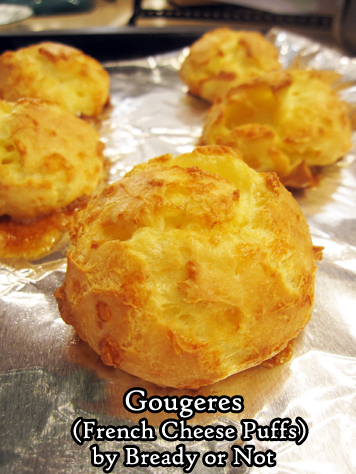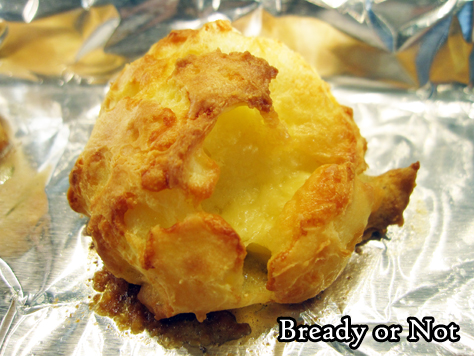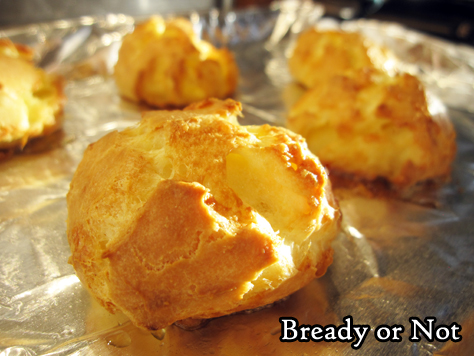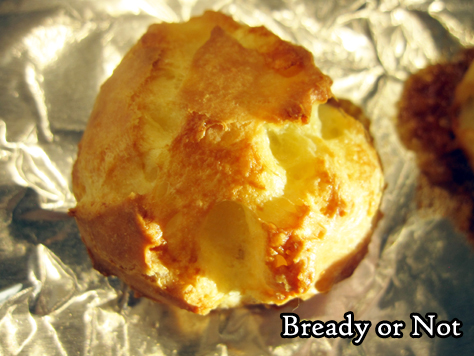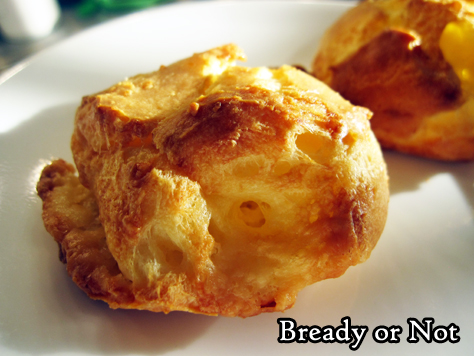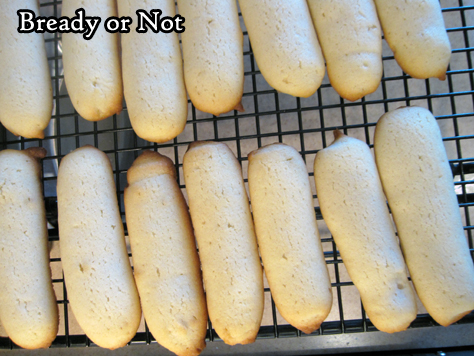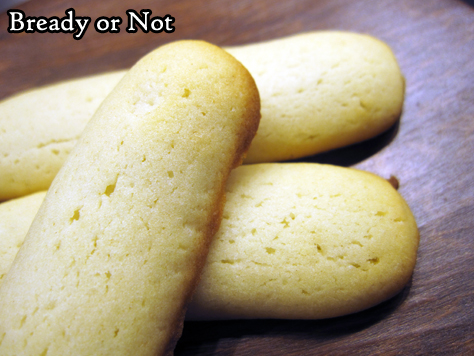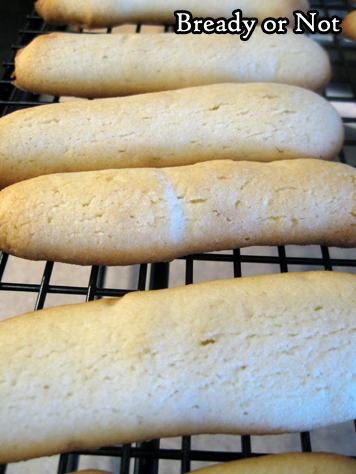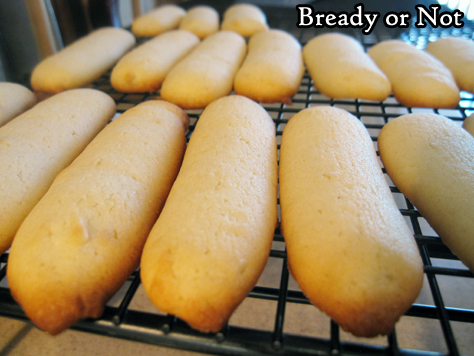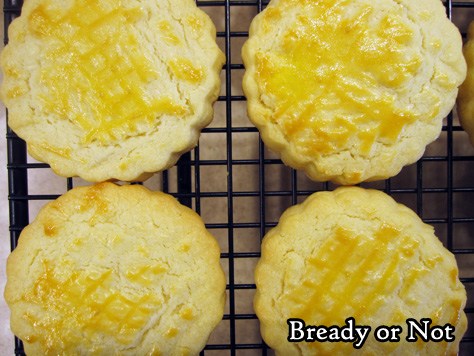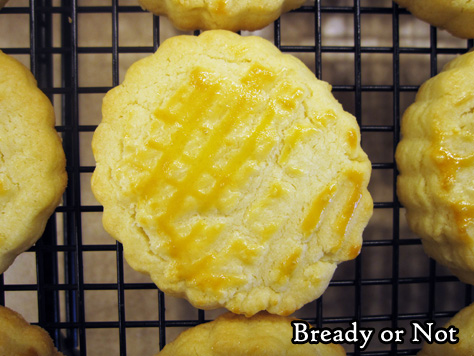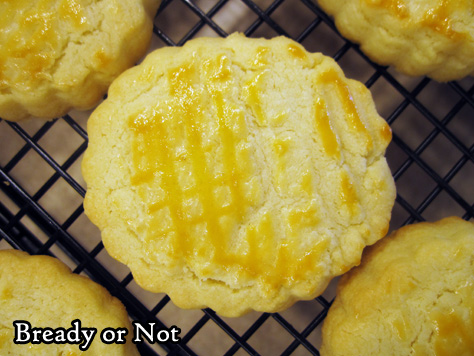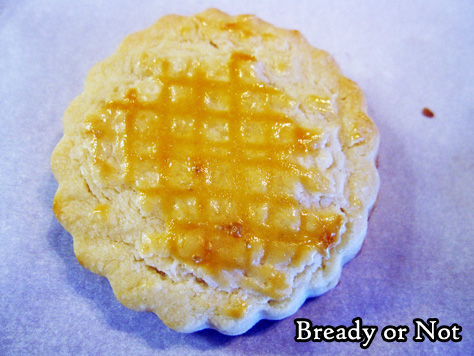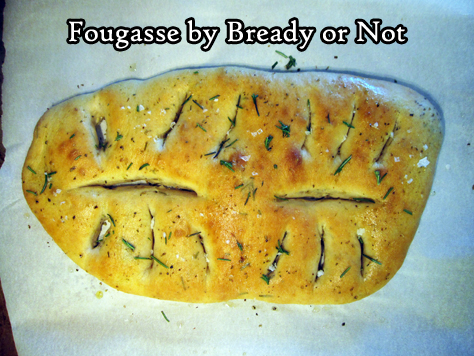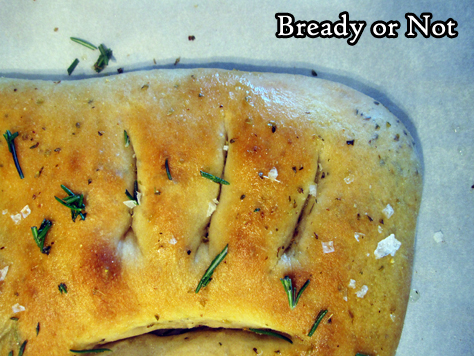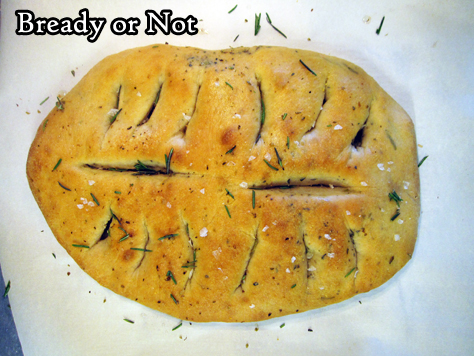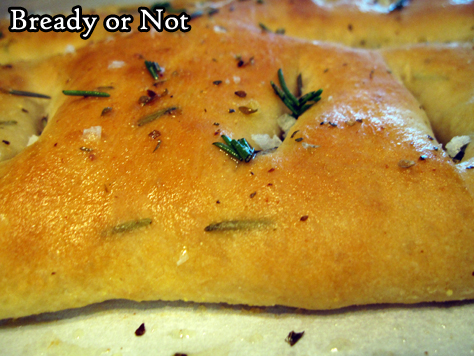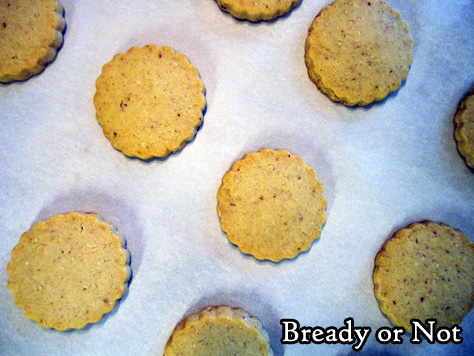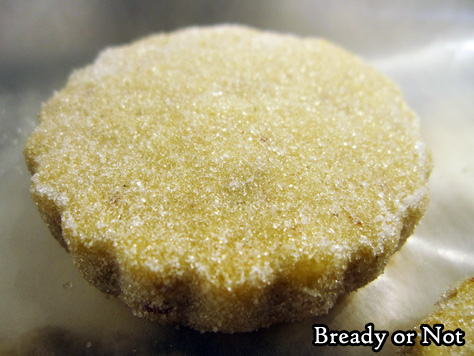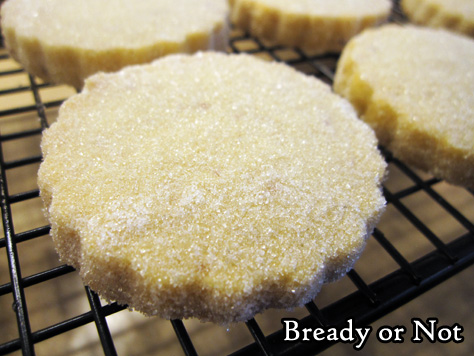Bready or Not: Gougeres (French Cheese Puffs)
Eat your cheese in delicious, airy form in Gougeres, aka French cheese puffs!
This is a savory version of pate a choux, the dough used for cream puffs and eclairs. In this case, though, you fold in a generous amount of grated cheese.
What kind of cheese? Go for ones that grate and melt. Traditional choices would include Gruyere or Comte, or be a rebel like me and use English cheddar. (Scandalous, I know.)
I modified this recipe from Dorie Greenspan’s version in her lovely tome Around My French Table. I felt like I learned something new every time I baked up a serving of these puffs, and I wanted to include all that info to prevent people from repeating my mistakes.
Such as, see the aluminum foil in these pictures? Don’t use that. Do parchment instead. I didn’t take pictures of how I mangled these gougeres, which were hopelessly stuck to the foil despite a spray of Pam.
The recipe results in about 30 puffs. These things keep well, unbaked and frozen, but only for about a month. After that, the puff declines and an eggy taste is more pronounced.
Bready or Not: Gougeres (French Cheese Puffs)
Equipment
- baking sheets
- parchment paper
- tablespoon scoop
- mixer
Ingredients
- 1/2 cup whole milk or half & half
- 1/2 cup water
- 8 Tablespoons unsalted butter (1 stick) cut into 4 pieces
- 1/2 teaspoon salt
- 1 cup all-purpose four
- 5 large eggs room temperature
- 1 1/2 cups coarsely-grated cheese (6 ounces) such as Gruyere, Comte, Emmenthal, or cheddar
Instructions
- If baking now, position racks in oven to be at the top and bottom. Preheat oven at 425-degrees. Line two large baking sheets with baking mats or parchment paper; do not use aluminum foil.
- If preparing the gougeres now, with plans to freeze and bake later, line a pan with waxed paper and clear some space in the freezer so the puffs can set.
- Place milk, water, butter, and salt in a medium saucepan. Bring to a fast boil. Add flour all at once, then lower heat. Promptly start stirring batter with a wooden spoon or sturdy whisk. The dough will come together, but keep stirring with vigor for another couple minutes until the dough is very smooth and looks dryer.
- Drop the dough into the big bowl of a stand-mixer or a bowl where a hand mixer can be used. (Or, if mixing by hand, be ready for an arm work-out.) Let the dough set for a couple minutes, then add the eggs one by one. Beat, beat, beat that batter, fully incorporating each egg before adding the next. If it separates, that's okay--keep beating it! It needs to reach a stage where it is thick and shiny. Beat in the grated cheese.
- The batter must be immediately doled out onto pans to either bake or freeze. Use a tablespoon or tablespoon-sized scoop to measure out the batter; if baking, space out about two inches apart.
- Slide baking sheets into oven. Immediately lower temperature to 375-degrees. Bake for 12 minutes, then rotate pans from front to back, top to bottom. Continue baking another 12 to 15 minutes, until gougeres are golden and firm. Note that they will not puff until the end of the bake. Serve promptly.
- If freezing some or all of the gougeres, freeze on waxed paper, then place in a freezer bag or lidded container. Bake straight from the freezer--do not thaw them! Place on parchment or a greased surface to cook, with gougeres in a central location in the oven. Eat frozen gougeres within a month, as they will otherwise taste increasingly eggy and have less rise.
OM NOM NOM!
Bready or Not: Cat Tongue Cookies (Langues de Chat)
Cat Tongue Cookies! NO CATS WERE HARMED IN THE MAKING OF THESE COOKIES.
I first heard about these cookies on the Great British Bake Off, where they were used as part of another recipe. My curiosity was piqued.
I am trying out a lot more French recipes. This seemed like a good, basic one to try… even though I HATE piping things. Did I say hate? I meant LOATHE.
That said, this recipe wasn’t too awful in that regard. The dough wasn’t a big sticky mess. I used a gallon Ziploc bag and cut the corner off, the old basic method, and that worked just fine.
The end result reminded me a lot of the old American stand-by, Nilla Wafers. Nothing fancy by themselves, but crisp and refreshing. They would be easy to dress up by dipping them in chocolate, Nutella, jam, whatever–if you want.
I thought they were just fine by themselves, with my cats lurking close by–tongues intact.
Bready or Not: Cat Tongue Cookies (Langues de Chat)
Equipment
- parchment paper
- piping bag or gallon Ziploc
Ingredients
- 9 Tablespoons unsalted butter softened
- 1/2 cup white sugar plus 2 Tablespoons
- 3 egg whites
- 1 1/2 teaspoons vanilla extract
- 1 1/2 cups all-purpose flour
Instructions
- Preheat oven at 400 degrees. Line a large baking pan with parchment. Use pencil to draw 3-inch lines spaced several inches apart in rows upon the paper, then flip over so the pencil lines still show through as guides.
- In a medium bowl, cream together butter and white sugar (1/2 cup and 2 Tablespoons) until smooth. Beat in egg whites one at a time until batter is light and fluffy. Stir in vanilla followed by flour. Dough might be stiff.
- Put about half of dough into a Ziploc bag (then cut off corner) or a piping bag with a medium star tip. Squeeze out dough onto the lines on parchment.
- Bake for 10 to 11 minutes, until edges are starting to brown. Move to cooling rack. Pipe and bake remaining dough, reusing parchment.
- Store in a sealed container. Good dipped into chocolate or spread with Nutella--or all by itself.
OM NOM NOM!
Bready or Not: Sable Breton (French Shortbread)
Last month I shared my recipe for Almond Sable. This time I present another French (from Brittany, to be specific) take on shortbread: Sable Breton!
These cookies are much more straightforward than the previous recipe. The ingredients are shortbread basics: butter, sugar, flour.
What sets this apart is, foremost, that it is not as sweet as its counterparts across the channel.
I also recommend that you use a kitchen scale to get that European-style precision–along with actual French butter. President-brand is expensive but widely available, even where I am in Arizona.
These cookies are downright pretty, too, with a crosshatched pattern and an egg yolk wash. They are perfect alongside a cup of coffee or tea!
Modified from the original at Mon Petit Four.
Bready or Not: Sable Breton (French Shortbread)
Equipment
- parchment paper
- small cookie cutter
- food scale
Ingredients
- 200 grams salted butter 1/2 cup plus 5 Tablespoons, President butter recommended
- 120 grams white sugar 1/2 cup plus 1 Tablespoon
- 3 egg yolks divided
- 1 teaspoon vanilla extract
- 280 grams all-purpose flour 2 cups plus 2 Tablespoons, plus more if needed to dust work surface
Instructions
- Preheat oven at 375-degrees. Line a large baking sheet with parchment paper or use a silicone mat.
- Beat together the butter and sugar until light and fluffy. Add two egg yolks and vanilla extract. Add flour until just incorporated.
- Lightly flour work surface and hands. Using rolling pin or hands, press dough to about 1/4-inch thickness.
- Use a small round cookie cutter on dough. Transfer rounds to cookie sheet, spaced out a bit. Use a fork to scratch a crosshatch pattern in the top, like a hashtag with more lines.
- Beat remaining egg yolk in a small bowl. Brush tops of cookies with yolk.
- Bake for 12 to 15 minutes, until cookies are a consistent golden color. Transfer to a rack to completely cool.
- Store in a sealed container.
- OM NOM NOM!
Bready or Not: Fougasse
Bready or Not goes full-on bready with this week’s feature: Fougasse, a French style of bread fragrant with herbs and formed into two leaf-shaped loaves.
I first encountered this bread on the Great British Bake Off, where it was presented as a technical challenge with minimal instructions. (I highly recommend watching season 4 episode 6 prior to baking, if you can, as it provides great tips and visuals of the bread).
I found this bread dough surprisingly easy to work with. I opted to make it in my Kitchen Aid, which is in line with the original recipe, but it could certainly be mixed in a bread machine or by hand.
The end result reminded me of focaccia with the herby, salty flavor, but I found the leaf shape of the fougasse to be incredibly fun. It really makes for a great presentation.
To use Bake Off terminology, this bread is a technical challenge that also works as a showstopper.
Modified from Paul Hollywood’s recipe as published on the BBC’s site.
Bready or Not: Fougasse
Equipment
- 2 large baking sheets
- parchment paper
- pizza cutter
- pastry brush
Ingredients
- 2 Tablespoons olive oil plus more for greasing and drizzling
- 500 grams bread flour plus more for dusting (1 lb, 2 ounces)
- 10 grams fine sea salt (1/4 teaspoon)
- 7 grams instant yeast (2 1/4 teaspoon)
- 350 ml warm water (12 ounces)
- 4 teaspoons chopped rosemary plus more to finish
- 2 teaspoons dried Italian seasoning
- fine cornmeal for dusting, or substitute semolina flour
- 1/2 teaspoon dried oregano
- sea salt flakes to finish
Instructions
- Grease a large container with some olive oil. Line two large baking sheets with parchment paper.
- In a mixer with a dough hook (or with a dough whisk and arm muscle), combine the bread flour and sea salt. Add yeast, followed by the measured olive oil and most of the warm water. Mix on low speed. As the dough comes together, slowly add the rest of the water. Continue to mix on medium speed for about 7 or 8 minutes. Add the herbs and make sure they are evenly distributed. Dough should be quite elastic and easy to work with.
- Dump the dough into the oiled container. Cover with plastic wrap and let rise until at least doubled, about an hour. Dough should be bouncy and shiny.
- Dust a work surface with extra flour and cornmeal (or semolina). Tip the dough onto the surface. It should be loose and flowing. Divide dough in half.
- Place each piece of dough on the prepared parchment. Spread into a flat oval, then use a pizza cutter to slice twice down the middle (to make a stem) with six cuts on the side of each leaf (see photograph for example). Gently stretch out the dough to emphasize the holes.
- Cover both loaves with plastic wrap and allow to set for 20 minutes as the oven preheats to 430-degrees.
- Brush or spray additional olive oil atop each leaf, then sprinkle on the dried oregano.
- Bake for about 7 minutes, then switch positions of bread on the oven racks. Continue baking another 8 minutes or so (15 to 20 minutes total) until each fougasse is golden and sounds hollow when tapped on the bottom. Remove from oven. Immediately brush more olive oil on top, followed by a sprinkling of sea salt.
- Bread is delicious fresh or at room temperature. Loaves can be well-wrapped and frozen for later enjoyment.
OM NOM NOM!
Bready or Not: Almond Sable Cookies
Let’s welcome 2020 in grand style: with French shortbread called almond sables!
I’ve made a lot of shortbread in my day. All varieties. This is shortbread that’s gone up in level. It tastes fancy. It’s a French recipe, so that’s only appropriate, right?
I highly recommend you use President-brand unsalted butter for this recipe. My recipe is actually modified from a version they used in advertisements. However, you can use other butters, just make sure you use unsalted and only 7 ounces. That means you’ll chop off a tablespoon from the standard American butter stick.
I made these cookies twice to get the recipe the way I wanted it. I used salted butter the first time, and the cookies tasted noticeably salty. Not just to me, but to other eaters as well.
Because these cookies have such few ingredients, the few that are present really have a chance to shine. They are buttery, mildly nutty, with a soft, sandy texture.
I liked using my fluted cookie cutters for these–that way the sugar coating has more nooks and crannies to cling to!
Recipe modified from a President butter advertisement.
Bready or Not: Almond Sable Cookies
Equipment
- small cookie cutter
- parchment paper
Ingredients
- 1/3 cup sliced almonds
- 2 cups all-purpose flour
- 7- ounces President unsalted butter softened, or substitute other unsalted butter
- 1/3 cup confectioners' sugar
- 3/4 cup white sugar divided
- 1 teaspoon kosher salt
- 1 vanilla bean or substitute 1 Tablespoon vanilla bean paste or 3 teaspoons vanilla extract
- 1 egg yolk
Instructions
- Toast the almonds prior to beginning cookies. Preheat oven at 325-degrees. Spread almonds in an even layer on a rimmed baking sheet. Toast for about 10 minutes, until fragrant. Set aside to cool for a few minutes; turn off oven.
- Measure out flour in a small bowl.
- Use a food processor to grind almonds to a fine crumb; don't process for too long or it'll turn to almond butter. Mix almond crumbs with flour.
- In a big bowl, beat butter until smooth. Add confectioners' sugar, 1/4 cup white sugar, and salt, until smooth again. Add vanilla bean (or equivalent) and egg yolk. Gradually work in flour mixture. Turn dough onto a lightly floured work surface, and knead 3 or 4 times to form a cohesive ball.
- Place dough between two large sheets of parchment paper and compress dough to about 1/2-inch thickness. Enshroud in plastic wrap. Transfer to fridge to set, at least 2 hours but as long as 2 days.
- Preheat oven to 325-degrees. Line large baking sheet with fresh parchment paper.
- Roll out dough to closer to 1/4-inch thickness, then set aside top parchment sheet. Use a small round cookie cutter to cut dough, placing rounds spaced-out on sheet pan. Re-roll dough scraps to use up the rest, adding a touch of water, if necessary, to bring dough together again.
- Bake until edges are just turning golden, about 15 to 20 minutes. Measure out remaining 1/2 cup white sugar in a bowl. Use a spatula to dip warm cookies into sugar to coat top and sides. Place on rack to cool cookies completely.
- Cookies keep well in sealed container for up to 3 days.




